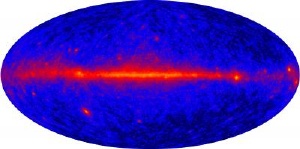Aug 27 2008
NASA's newest observatory, the Gamma-Ray Large Area Space Telescope, or GLAST, has begun its mission of exploring the universe in high-energy gamma rays. The spacecraft and its revolutionary instruments passed their orbital checkout with flying colors.
 This all-sky view from GLAST reveals bright emission in the plane of the Milky Way (center), bright pulsars and super-massive black holes. Credit: NASA/DOE/International LAT Team
This all-sky view from GLAST reveals bright emission in the plane of the Milky Way (center), bright pulsars and super-massive black holes. Credit: NASA/DOE/International LAT Team
NASA announced today that GLAST has been renamed the Fermi Gamma-ray Space Telescope. The new name honors Prof. Enrico Fermi (1901 - 1954), a pioneer in high-energy physics.
"Enrico Fermi was the first person to suggest how cosmic particles could be accelerated to high speeds," said Paul Hertz, chief scientist for NASA's Science Mission Directorate at NASA Headquarters in Washington. "His theory provides the foundation for understanding the new phenomena his namesake telescope will discover."
Scientists expect Fermi will discover many new pulsars in our own galaxy, reveal powerful processes near supermassive black holes at the cores of thousands of active galaxies and enable a search for signs of new physical laws.
For two months following the spacecraft's June 11 launch, scientists tested and calibrated its two instruments, the Large Area Telescope (LAT) and the GLAST Burst Monitor (GBM).
The LAT team today unveiled an all-sky image showing the glowing gas of the Milky Way, blinking pulsars, and a flaring galaxy billions of light-years away. The map combines 95 hours of the instrument's "first light" observations. A similar image, produced by NASA's now-defunct Compton Gamma-ray Observatory, took years of observations to produce.
The image shows gas and dust in the plane of the Milky Way glowing in gamma rays due to collisions with accelerated nuclei called cosmic rays. The famous Crab Nebula and Vela pulsars also shine brightly at these wavelengths. These fast-spinning neutron stars, which form when massive stars die, were originally discovered by their radio emissions. The image's third pulsar, named Geminga and located in Gemini, is not a radio source. It was discovered by an earlier gamma-ray satellite. Fermi is expected to discover many more radio-quiet pulsars, providing key information about how these exotic objects work.
A fourth bright spot in the LAT image lies some 7.1 billion light-years away, far beyond our galaxy. This is 3C 454.3 in Pegasus, a type of active galaxy called a blazar. It's now undergoing a flaring episode that makes it especially bright.
The LAT scans the entire sky every three hours when operating in survey mode, which will occupy most of the telescope's observing time during the first year of operations. These fast snapshots will let scientists monitor rapidly changing sources.
The instrument detects photons with energies ranging from 20 million electron volts to over 300 billion electron volts. The high end of this range, which corresponds to energies more than 5 million times greater than dental X-rays, is little explored.
The spacecraft's secondary instrument, the GBM, spotted 31 gamma-ray bursts in its first month of operations. These high-energy blasts occur when massive stars die or when orbiting neutron stars spiral together and merge.
The GBM is sensitive to less energetic gamma rays than the LAT. Bursts seen by both instruments will provide an unprecedented look across a broad gamma-ray spectrum, enabling scientists to peer into the processes powering these events.